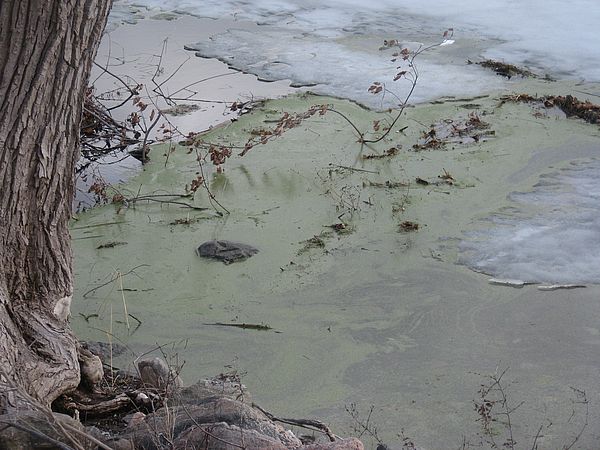Algae blooms are usually considered a thing of summer, but some algae populations will grow while still under the ice. So long as light is able to penetrate the snow and ice over the lake, algae can take advantage of it. The group of algae best suited to take advantage of the under-ice environment is the diatoms, species encased in beautiful microscopic silica shells. Nuisance summer blooms of blue-green algae are still months away.
Although blue-green algae regularly make the headlines because of their ability to form blooms and occasionally produce of toxins, these species dominate in very nutrient rich waters later in the summer. Most of the lake and most of the year the algal community is unremarkable in human terms. We don’t see them, and they don’t irritate us. Only when one looks through a microscope do the delicate shapes and forms of the diatoms appear.
During the Victorian age in England, microscopes were popular with the well-to-do, and diatoms were one of the favored subjects of study. Patient artists would even arrange the ornate cells in intricate patterns creating works of art. Some of the resulting preserved slides are on display in museums today.
The elaborate shapes occur because diatoms live within “glass houses”. Their cell walls are made of two plates of silica, the thinnest windows imaginable. Apparently the glass plates help them accumulate carbon dioxide and increase the efficiency of photosynthesis. The intricate shapes of the diatoms, so intriguing under the microscope, increase the surface area of the organisms further enhancing carbon dioxide accumulation.
Classification of diatoms is based upon variations in the shape of their glass houses. Centric diatoms are rounded. The round shape makes them quite buoyant, and they are more common in marine environments than the second group. Pennate diatoms can be elongated or flattened, but they all have bilateral symmetry. This means only one imaginary line drawn through an individual can divide it into two nearly identical halves. Humans are also bilaterally symmetrical. Most freshwater diatoms, including all the ones described in the opening paragraph, are pennate (The eight-spoked star is actually a colony of eight different individuals).
In addition to their beauty, diatoms are ecologically important. They are thought to capture 20-25% of all the sun energy in the world used for living organisms. Of course, most of this capture takes place in the oceans. Their tremendous ability to convert sunlight to usable energy makes them critically important in the lake food web, as they provide sustenance for many of the zooplankton upon which fish feed.
Typically when we think of capturing sunlight we think of green plants. However, diatoms appear more yellow-brown. This is because they utilize accessory pigments in addition to the more typical green chlorophyll. These accessory pigments absorb light of longer wavelengths, hence the difference in color. Longer wavelengths offer less energy, but penetrate farther into the water. So what the diatoms lose in efficiency, they regain by their ability to thrive in deeper water.
Changes in diatom communities can be linked to changes in the ecological condition of the water body in which they live. Since the silica of diatoms accumulates, lake cores may show different species compositions over time. In this way, diatoms have been used to assess the extent of acidification of Adirondack Lakes, and to determine changes in the nutrient status of lakes throughout North America.
In Lake Champlain, as in most lakes, diatoms are abundant during the spring and early summer when excess silica from spring runoff promotes their growth. Silica becomes less available later in the summer. First the diatoms tie it up, and then it becomes trapped in the organisms that eat the diatoms or it sinks to the bottom of the lake as diatoms die.
Since glass doesn’t readily dissolve back into the water column, once diatoms settle to the bottom of the water column the silica they brought down stays there, accumulating over millennia. Two commercially valuable products have resulted from ancient accumulations of diatoms. One, diatomaceous earth, is commonly used for filtration, as a polish, in paints to increase reflectivity, or as insulation. The other, resulting from even older deposits, is the oil that today fuels our cars and heats our homes.
